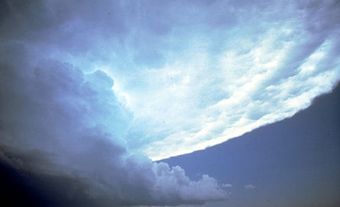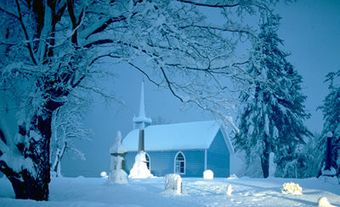This article was originally published in Maclean's Magazine on October 27, 2003
Hurricane Devastates Halifax's Trees
JOHN SIMMONS steps over the trunk of a splintered spruce, lets out a weary sigh and points off to the left, over the twisted, mangled corpses of pines and birches lining Sailors' Memorial Way in HALIFAX'S Point Pleasant Park. "There's one we can save," says Halifax's urban forest supervisor. "There's two, there's three. That's about it." Depressingly few, considering that the same vista used to be crowded with 500 or so healthy trees. But that was before HURRICANE Juan howled in off the Atlantic early on Sept. 29. A few hours later, Point Pleasant had lost 75 per cent of its 80,000 trees. They were the work of a lifetime for Art Sampson, supervisor of major parks for the city, who has spent almost 30 years working in Point Pleasant. Surveying the carnage from a few feet away, he says, barely audibly, "It's hard to see." Yes it is: they used to call Point Pleasant Halifax's jewel. Now it looks like a giant has used it as a bowling alley.
Outside the park, in the downtown and residential neighbourhoods where the power is back on and the fallen trees removed, Halifax seems back to normal. But go down Binney Street, which has lost a dozen trees on its two blocks. Or drive along Jubilee Road past the houses now shorn of the big elms and maples that have stood on front lawns since the turn of the last century. So far, it's impossible to calculate how many trees were uprooted or irrevocably damaged in the storm. "It's apocalyptic," says Jeff Monty, president of the Ottawa-based Tree Canada Foundation, which has set up a Maritime Hurricane Releaf fund on its Web site.
Juan took two lives and will cost the city an estimated $40 million when all the bills are in. People are responding: they ponied up more than $1 million during a radio fundraiser for the storm-flattened Public Gardens, and a steady stream of companies and individuals are calling city hall to pledge cash for Point Pleasant. But putting a price tag on the forest of fallen trees will take more than an accountant with a calculator. Halifax's hundreds of thousands of trees have made it, on a square-footage basis, Canada's largest "urban forest" - it's been at least 40 per cent tree-covered, nearly double that of, say, Toronto, which calls itself "a city in a forest."
And Halifax's tree cover has also been one of the most diverse on the continent: in addition to all the native species, European settlers have been planting Old World varieties here since Edward Cornwallis and his troops arrived from England in 1749. The beloved Public Gardens, which lost some 60 trees to Juan, boasts transplants from as far away as China and Cyprus. You can also glimpse Norway maples, Scotch pines, English beeches, as well as varieties of lindens, oaks and ashes from Europe that have been adorning Halifax's streets and parkland for up to two centuries. In spots it's even possible to tell a neighbourhood's history by looking at the trees - for example in the city's North End, where the relatively immature oaks and elms were planted after the 1917 explosion that levelled the area.
Juan was devastating in a different way. Trees on streets running east to west suffered the most because they were hit broadside by the storm surge from the south. Rambling oaks and elms, with canopies too big to be shielded by surrounding buildings, were uprooted, sheared off at the tops or splintered. Birches, spruce and other shallow-rooted trees were easily ripped from the ground. "Every tree has a weakness," says Simmons. "It might be the roots, the canopy, the trunk or the branches. A hurricane has a way of finding them."
Every tree lost will have an effect on the city. Trees cool the air, filter out carbon dioxide, and provide homes for insects and animals. "Without trees we wouldn't be alive," says Stephen King, a senior adviser to the city on sustainable resource management. At the very least, the quality of life declines: a growing body of research shows that looking out of the window at a natural treed landscape improves concentration, reduces stress and helps people recover better from trauma. Experts even think having trees around promotes closer ties with neighbours, reduces domestic and neighbourhood crime and helps calm kids with attention deficit disorder. "There are a whole host of consequences to losing a good number of trees in a community," stresses William Sullivan, associate professor of natural resources and environmental sciences at the University of Illinois, and an expert on the relationship between the environment and health.
So, now what? Because of a shortage of funds in recent years, Halifax had been planting only a few hundred seedlings annually - far less than the thousands needed to maintain the city's tree canopy. King is confident the city will come through with the cash for a sweeping new urban-forest master plan for Halifax, which was already being planned when Juan hit. But any replanting will have to wait. For now, the main focus is on citizen safety and dealing with the countless tonnes of fallen trees.
Walking through Point Pleasant, Simmons talks about the park's ability to regenerate itself. It is, after all, a remnant of the Acadian hardwood forests that have blanketed Nova Scotia since the ice age. "Nature looks after itself," he says. Even if it sometimes seems to be Halifax's worst enemy.
Maclean's October 27, 2003

 Share on Facebook
Share on Facebook Share on X
Share on X Share by Email
Share by Email Share on Google Classroom
Share on Google Classroom


